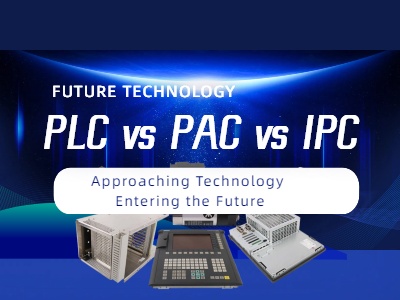Khi nói đến tự động hóa công nghiệp, việc lựa chọn hệ thống điều khiển phù hợp là rất quan trọng đối với hiệu quả và độ tin cậy của hoạt động của bạn. Các tùy chọn có sẵn—Bộ điều khiển logic lập trình (PLC), Bộ điều khiển tự động hóa lập trình (PAC) và Máy tính công nghiệp (IPC)—mỗi tùy chọn đều mang lại những lợi ích riêng. Hiểu được sự khác biệt giữa các hệ thống này có thể giúp bạn đưa ra quyết định sáng suốt về hệ thống nào phù hợp với nhu cầu kinh doanh của mình.

PLC là giải pháp đã được thử nghiệm và chứng minh là giải pháp chủ chốt trong các hệ thống điều khiển công nghiệp kể từ những năm 1960. Ban đầu, nó được phát triển để thay thế các hệ thống điều khiển dựa trên rơ le trong ngành sản xuất ô tô và nhanh chóng mở rộng sang các ngành khác như thực phẩm và đồ uống, lắp ráp điện tử và dược phẩm. PLC được thiết kế cho các tác vụ điều khiển đơn giản, riêng biệt và hoạt động tốt trong các môi trường đòi hỏi hoạt động tốc độ cao và độ bền cao. Đây là lựa chọn phổ biến để điều khiển máy móc tự động và dây chuyền sản xuất.
PAC kết hợp các chức nÄng truyá»n thá»ng của PLC vá»i các tÃnh nÄng Äiá»u khiá»n tiên tiến hÆ¡n thÆ°á»ng thấy trong PC công nghiá»p. PAC linh hoạt và có khả nÄng má» rá»ng hÆ¡n PLC, cung cấp sức mạnh xá» lý cao hÆ¡n và phạm vi khả nÄng Äiá»u khiá»n rá»ng hÆ¡n. Chúng thÆ°á»ng Äược sá» dụng trong các ứng dụng Äòi há»i các chiến lược Äiá»u khiá»n phức tạp, quản lý dữ liá»u và tÃch hợp vá»i các há» thá»ng khác. Nếu bạn có môi trÆ°á»ng sản xuất lá»n hÆ¡n, nÄng Äá»ng hÆ¡n, PAC có thá» cung cấp tÃnh linh hoạt và khả nÄng xá» lý các tác vụ phức tạp hÆ¡n so vá»i PLC tiêu chuẩn.
IPC đưa tự động hóa công nghiệp lên một tầm cao mới bằng cách kết hợp sức mạnh và tính linh hoạt của một máy tính hoàn chỉnh. IPC thường được sử dụng khi hệ thống điều khiển yêu cầu nhiều tài nguyên điện toán, chẳng hạn như thu thập dữ liệu, xử lý thời gian thực và phân tích nâng cao. Các hệ thống này lý tưởng cho các môi trường mà tính linh hoạt, sức mạnh xử lý cao và khả năng mở rộng là chìa khóa. IPC cũng có thể chạy phần mềm phức tạp, bao gồm hệ thống lập kế hoạch nguồn lực doanh nghiệp (ERP), khiến chúng phù hợp với các quy trình sản xuất và kinh doanh tích hợp.
Viá»c lá»±a chá»n giữa PLC, PAC hay IPC phụ thuá»c và o yêu cầu của ứng dụng. Nếu hoạt Äá»ng của bạn tÆ°Æ¡ng Äá»i ÄÆ¡n giản, vá»i nhu cầu Äiá»u khiá»n riêng biá»t, trá»±c tiếp, thì PLC có thá» là lá»±a chá»n phù hợp nhất. Tuy nhiên, Äá»i vá»i các tác vụ tá»± Äá»ng hóa phức tạp hÆ¡n Äòi há»i các chiến lược Äiá»u khiá»n tiên tiến, tÃch hợp và khả nÄng má» rá»ng, thì PAC có thá» là lá»±a chá»n tá»t hÆ¡n. Nếu hoạt Äá»ng sản xuất của bạn liên quan Äến lượng lá»n dữ liá»u xá» lý, phân tÃch nâng cao hoặc tÃch hợp vá»i các há» thá»ng cấp cao hÆ¡n, thì IPC có thá» là giải pháp lý tÆ°á»ng.
Thế giá»i của các há» thá»ng Äiá»u khiá»n công nghiá»p có thá» rất choáng ngợp, nhÆ°ng hiá»u Äược sá»± khác biá»t giữa PLC, PAC và IPC là bÆ°á»c Äầu tiên Äá» lá»±a chá»n giải pháp phù hợp cho doanh nghiá»p của bạn. Trong khi PLC rất phù hợp cho các tác vụ ÄÆ¡n giản, tá»c Äá» cao, PAC cung cấp khả nÄng má» rá»ng và các chức nÄng Äiá»u khiá»n phức tạp hÆ¡n, còn IPC cung cấp sức mạnh tÃnh toán cho các môi trÆ°á»ng tÃch hợp, dá»±a trên dữ liá»u. Bằng cách Äánh giá cẩn tháºn nhu cầu tá»± Äá»ng hóa của bạnâxem xét các yếu tá» nhÆ° Äá» phức tạp, quy mô và yêu cầu dữ liá»uâbạn có thá» ÄÆ°a ra quyết Äá»nh sáng suá»t và lá»±a chá»n há» thá»ng Äiá»u khiá»n sẽ tá»i Æ°u hóa hoạt Äá»ng của bạn trong nhiá»u nÄm tá»i.
Nếu bạn cần thêm sản phẩm, vui lòng liên há» vá»i chúng tôi!
Thư điện tử:plcsale@mooreplc.com